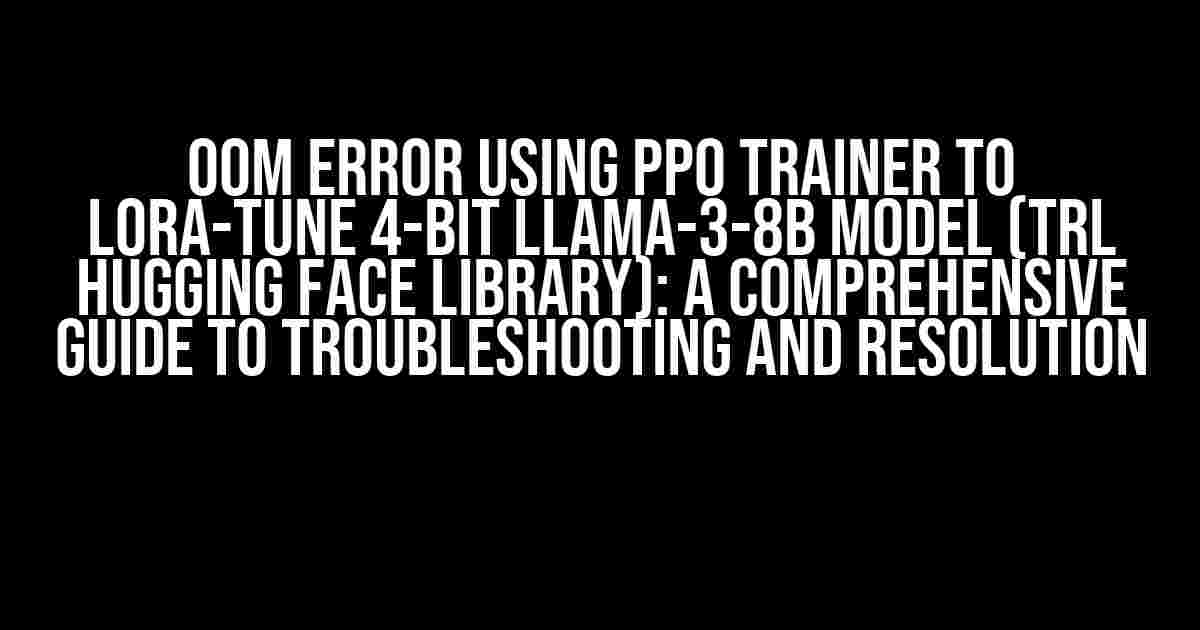Are you tired of encountering the frustrating “Out of Memory” (OOM) error when attempting to LoRa-tune your 4-bit Llama-3-8B model using the PPO Trainer from the TRL Hugging Face Library? You’re not alone! This error can be a significant obstacle in your machine learning workflow, but fear not, dear reader, for we’re about to embark on a journey to conquer this issue once and for all.
Understanding the OOM Error
The OOM error occurs when the system runs out of memory to allocate to the model, causing the training process to fail. This error is particularly common when working with large models, datasets, or complex workflows like LoRa-tuning. To tackle this issue, we need to understand the underlying causes and identify potential solutions.
Cause 1: Insufficient GPU Memory
One of the primary causes of the OOM error is insufficient GPU memory. When the PPO Trainer attempts to allocate memory for the 4-bit Llama-3-8B model, it may exceed the available GPU memory, resulting in the error.
torch.cuda.memory_allocated() can help you monitor the GPU memory usage. Run this command to check the current memory allocation:
import torch
print(torch.cuda.memory_allocated())Cause 2: Inefficient Model Architecture
The 4-bit Llama-3-8B model’s architecture might be inefficient, leading to excessive memory usage. This can be due to the model’s size, the number of layers, or the type of layers used.
Use the torchinfo library to analyze the model’s architecture and identify potential bottlenecks:
import torchinfo
from transformers import LLaMAForSequenceClassification
model = LLaMAForSequenceClassification.from_pretrained("llama-3-8b")
torchinfo.summary(model, input_size=(1, 512))Resolving the OOM Error
Now that we’ve identified the potential causes, it’s time to explore solutions to resolve the OOM error:
Solution 1: Reduce Model Size
One approach is to reduce the model size by pruning or compressing the 4-bit Llama-3-8B model. This can be achieved using techniques like knowledge distillation, quantization, or pruning:
import torch.nn.utils.prune as prune
module = nn.Sequential(*[module for module in model.modules() if isinstance(module, nn.Conv2d)])
prune.ln_structured(module, name='weight', amount=0.2)Solution 2: Gradient Checkpointing
Gradient checkpointing is a technique that stores only the gradients of the model’s parameters at certain intervals, reducing memory usage. This can be implemented using the torch.utils.checkpoint module:
import torch.utils.checkpoint as cp
def checkpoint_forward(model, input_ids, attention_mask):
with cp.checkpoint():
outputs = model(input_ids, attention_mask)
return outputsSolution 3: Gradient Accumulation
Gradient accumulation involves accumulating gradients over multiple batches before updating the model’s parameters. This reduces the memory required for storing gradients:
accum_steps = 4
for step in range(accum_steps):
inputs, labels = batch
outputs = model(inputs, labels)
loss = criterion(outputs, labels)
loss.backward()
optimizer.step()
optimizer.zero_grad()Solution 4: Mixed Precision Training
Mixed precision training uses lower precision data types (e.g., float16) to reduce memory usage. This can be implemented using the apex library:
import apex
apex.amp.initialize(model, optimizer, opt_level='O1')Solution 5: Model Parallelism
Model parallelism involves splitting the model across multiple GPUs, reducing the memory requirements per device:
import torch.distributed as dist
def parallelize_model(model, gpu_ids):
model = nn.parallel.DataParallel(model, device_ids=gpu_ids)
gpu_ids = [0, 1, 2, 3]
model = parallelize_model(model, gpu_ids)Best Practices for Avoiding OOM Errors
To avoid OOM errors in the future, follow these best practices:
-
Monitor GPU memory usage using
torch.cuda.memory_allocated(). -
Use model pruning, quantization, or knowledge distillation to reduce model size.
-
Implement gradient checkpointing or gradient accumulation to reduce memory requirements.
-
Use mixed precision training with lower precision data types.
-
Parallelize your model across multiple GPUs using model parallelism.
-
Optimize your dataset and workflow to reduce memory usage.
Conclusion
In conclusion, resolving the OOM error when using the PPO Trainer to LoRa-tune the 4-bit Llama-3-8B model requires a combination of understanding the underlying causes and applying the right solutions. By following the guidelines and best practices outlined in this article, you’ll be well-equipped to tackle this challenge and successfully train your model.
Remember, troubleshooting OOM errors is an iterative process that requires patience, persistence, and creativity. Don’t be afraid to experiment with different solutions and tailor them to your specific use case.
| Solution | Description |
|---|---|
| Reduce Model Size | Prune or compress the model to reduce memory usage |
| Gradient Checkpointing | Store gradients at certain intervals to reduce memory usage |
| Gradient Accumulation | Accumulate gradients over multiple batches before updating parameters |
| Mixed Precision Training | Use lower precision data types to reduce memory usage |
| Model Parallelism | Split the model across multiple GPUs to reduce memory requirements per device |
We hope this comprehensive guide has empowered you to overcome the OOM error and successfully LoRa-tune your 4-bit Llama-3-8B model using the PPO Trainer from the TRL Hugging Face Library. Happy training!
Frequently Asked Question
Get instant answers to your pressing questions about OOM error using PPO Trainer to LoRa-tune 4-bit Llama-3-8B Model (TRL Hugging Face Library)
What is the OOM error, and why does it occur when using PPO Trainer to LoRa-tune 4-bit Llama-3-8B Model?
The OOM (Out of Memory) error occurs when the PPO Trainer attempts to utilize more memory than is available, typically due to the large size of the model and the batch size. This can happen when using the LoRa-tune 4-bit Llama-3-8B Model, which is a large and complex model requiring significant computational resources.
How can I reduce the batch size to mitigate the OOM error when using PPO Trainer to LoRa-tune 4-bit Llama-3-8B Model?
To reduce the batch size, you can adjust the `batch_size` parameter in the PPO Trainer configuration. A smaller batch size reduces the memory requirements, but it may increase the training time. You can start by reducing the batch size by half and adjusting it further as needed to find a balance between memory usage and training speed.
What are some other possible solutions to address the OOM error when using PPO Trainer to LoRa-tune 4-bit Llama-3-8B Model?
In addition to reducing the batch size, you can try other solutions such as model pruning, knowledge distillation, or using a more efficient model architecture. You can also consider using a more powerful machine with increased memory or distributing the training process across multiple machines using distributed computing.
Can I use gradient checkpointing to reduce memory usage when training the 4-bit Llama-3-8B Model with PPO Trainer?
Yes, gradient checkpointing can be an effective technique to reduce memory usage when training large models like the 4-bit Llama-3-8B Model. By storing only the gradients of the model’s weights at certain intervals, you can significantly reduce the memory required for training. However, this may come at the cost of increased computation time.
Are there any pre-trained models available that can be fine-tuned for my specific task, reducing the need for large-scale training and OOM errors?
Yes, the Hugging Face library provides a wide range of pre-trained models, including the 4-bit Llama-3-8B Model, which can be fine-tuned for your specific task. Fine-tuning a pre-trained model can significantly reduce the training time and memory requirements, making it a more efficient and error-free approach.




